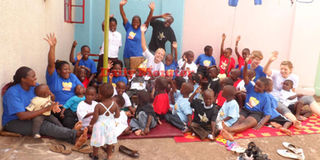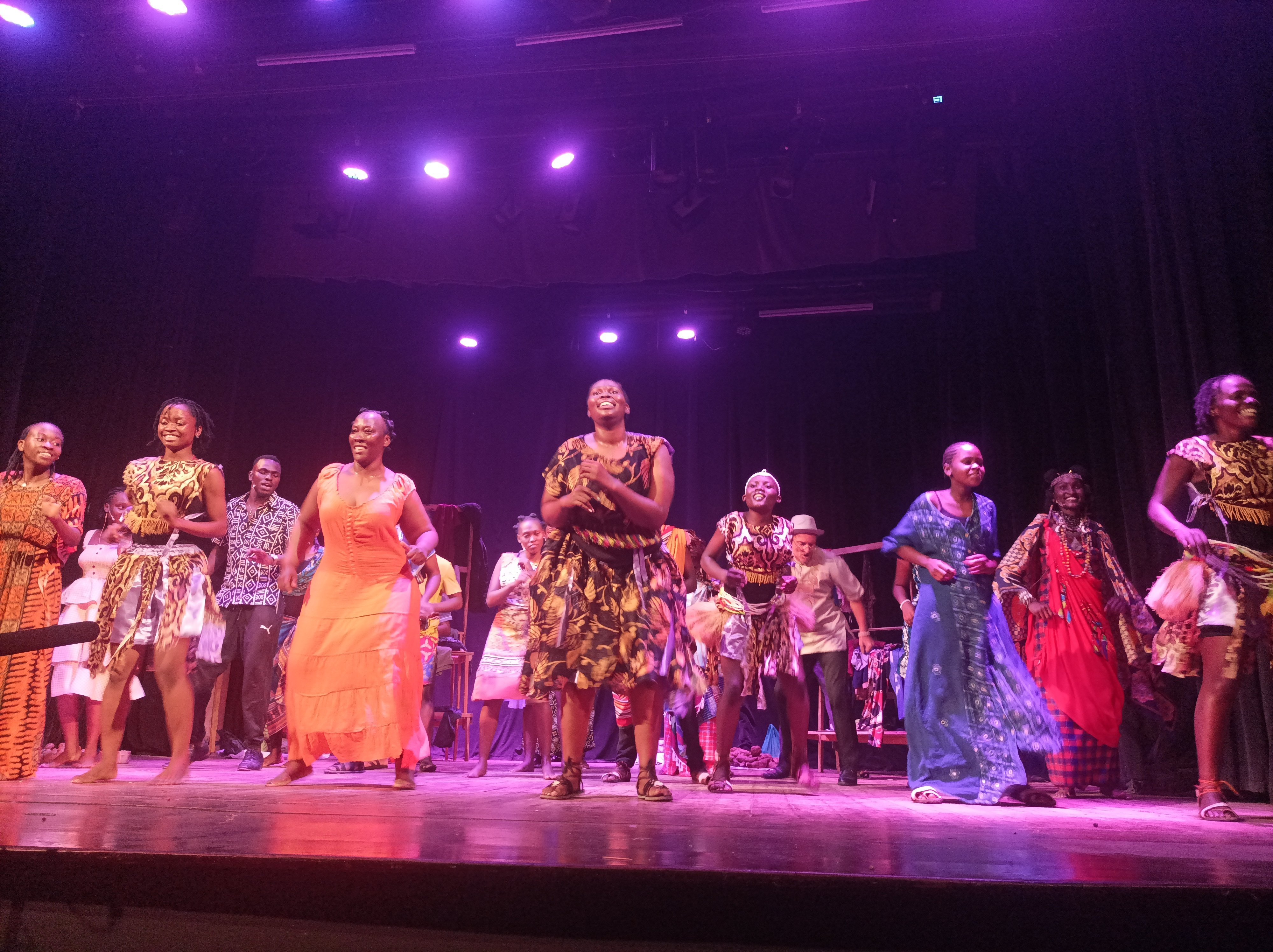Woman passionate about special needs children

At Angel’s Centre for Children with Special Needs, children are equipped with skills on how to get by on their own. The caregivers and children celebrate milestones like birthdays or acquiring a new skill to motivate them. PHOTO BY PAULINE BANGIRANA
What you need to know:
With about seven million people with Down’s Syndrome living worldwide, it is the most common and recognised form of learning disability. Most people with Down’s Syndrome face a harsh reality of low life expectancy, physical and psychological abuse, stigma and segregation, and very limited life opportunities as children and adults. Rosemary Nambooze Nuwagaba, a mother of three, is determined to make a difference in the lives of not only sufferers but also parents by creating an enabling environment.
In Uganda, there are few facilities that have been set up to ease the lives of children with Down’s Syndrome. Among those are Angel’s Centre For Children With Special Needs. Located in Nansana, a city suburb. The centre has for the last three years been a solace for children with Down’s Syndrome. She is Rosemary Nambooze Nuwagaba, a mother of three, is the brain behind the facility.
Motivation
Like most parents, Down’s Syndrome was something she had never heard about until it afflicted her household.
Her second-born child, five-year-old Abryl Nuwagaba, is the motivation for setting up the centre. When I visited the centre, Abryl was asleep, which gave Nambooze an opportunity to bring me up to speed.
It was 2010, an exciting year for her as she had not only got a scholarship in Belgium to pursue a Master’s degree in Development Studies, but she was also expecting her second child. She says, “I was excited about the possibilities. I thank God that on December 14, that year, I gave birth to a baby boy from Belguim.” All indications pointed to a normal birth. “My expectations as a mother were to nurture my son into an engineer like his grandfather,” she says.
But it seems fate had other plans for Nambooze because doctors said Abryl lacked vital heart beat at birth.
“Immediately after birth, we were transferred to another medical facility with better services and equipment. He was put on oxygen. I was crashed because I did not know what to expect. I was in a foreign country and it seemed like my son was not getting any better.
Nambooze explains, “His body colour changed and I was scared. We were told that he had a heart problem. Two days later, they required a blood transfusion. Doctors thought he would not survive.”
Turning point
However, Nambooze and her family remained strong, hoping for a miracle. It did not take long before the doctors informed her that her son had Down’s Syndrome.
“I was devastated and felt like my world was crumbling. However, since the condition was new to me, I vowed to care for my son and help parents in similar situations.”
With this determination, a dream to build a centre for children with Down’s Syndrome was born. “I spent one-and-a-half years in the hospital looking after my child; this is where the dream of starting Angel’s Centre was developed,” Nambooze says. That was her mission when she returned from Belgium.
Midway the interview, we have to pause because Abryl had woken up. Her face literally lights up as she turns to me saying, “You have to meet him.” I turn only to catch the back of a little boy disappearing into the corridors.
I am anxious not sure of how to react when I meet a child who is different. (It is not that I have not met any like him before, but I get overwhelmed in such situations.) Just as I am pondering, I feel a little tap on my leg, it is Abryl. He cheekily says, “Auntie how are you? You are welcome.”
My heart melts and I feel a gush of tears rolling down. I fight to hold them back so that I can continue with the interview. Abryl is a sweet boy and as he goes about his business, I begin to understand why Nambooze is passionate about Angel’s Centre.
“He is our superstar because he has undergone various surgeries.” Her husband, Alfred Nuwagaba, says he was hurt when he learnt that his child was a special needs case. “However, I was counselled and came to terms with the situation.”
Making the centre a reality
Using a Shs14m grant from the City of Antwerp o and some money from parents with children with disability in Belguim and their own savings, Nambooze and her husband started the centre in 2012. She says before starting she carried out intensive awareness campaigns in the community appealing to parents with special needs children.
“At first, I was discouraged because people in the community thought the centre would not stay for long.” But not one to give up without a fight, Nambooze started with 10 children. The aim was to create an enabling environment for such children to play.
“Most parents are compromised because house helps are impatient and cruel towards such children,” she adds.
Angel’s Centre is a platform for parents with different children to share information on how best our children can be loved and cared for, especially in areas such as concentration, toilet training and overcoming the stigma.
Life at the centre
At Angel’s Centre, one is welcomed by a play compound with a few playthings for children.
Opposite the gate is the administration block which doubles as the reception. A medium noticeboard hangs on the wall that has pictures of some of the children.
There are eight trainers who deal with the children daily; teaching and supporting children in activities they can do without adult supervision.
Nambooze says: “I must admit that the journey has not been smooth. With all the support we provide these children, we lack financial aid yet we are dealing with vulnerable parents who cannot fully afford the costs and as such, paying the trainers and teachers is sometimes difficult.”
There is the issue of stereo-typing from the community. Some people in the community refer to special needs children as kasilu, kidomola, cabbage. This, Nambooze says demotivates both parents and the staff.
But that will not bog down Nambooze’s efforts of making a difference. “Supporting these children to become self-reliant and watching them become better motivates me to keep going on.”
She adds, that the centre’s success is measured by the children we have been able to help and the parents whose relationships have improved through the counselling we provide.”
The centre boasts of 60 children but there are others who attended to off-site.
The rewards

Rosemary Nambooze Nuwagaba, a mother of three, is determined to make a difference in the lives of Children with Special Needs PHOTO BY PAULINE BANGIRANA
As Nambooze goes about with her journey, I cannot help but notice a trophy in the corner of her office. It is similar to a small bowl, colourful with a peacock motif. As soon as she notices what is diverting my attention, she tells me that it is an award she got in June in recognition of her work. The Down’s Syndrome International award was given to her from India. Angel Centre is affiliated to Down’s Syndrome International where reports on their progress have been published.
“I must admit that I am not the only person with a child who has Down’s Syndrome but I decided to use my circumstances for the greater good.”
As we conclude the interview, I look around for Abryl to bid him farewell. Smiling from ear to ear, he looks up, waves his little hand at me and tells me to “come again.”
There and then, I know that perhaps he does not even realise that he is the reason that several others like him have a place to belong to.
What is Down’s Syndrome
Down’s Syndrome is a life-long abnormality; a person with this deficiency has an extra chromosome although the causes are not yet known, there are factors associated with someone having children with Down’s Syndrome. These include; giving birth at a later stage.
“Chances are higher when a woman above 40-years gets pregnant and as such, chances of giving birth to a child with Down’s Syndrome will be higher although this does not mean that those below 40 do not produce such children,” explains Dr Dennis Muyaka of Mulago hospital .
Dr Muyaka notes that due to the chromosomal abnormalities, the growth and development of the body system is affected. “Most of the times, someone with Down’s Syndrome presents with mental retardation, their muscle tones are reduced and as such, their bodies are usually soft, have heart problems and are prone to pneumonia.”
Most children with Down’s Syndrome are sometimes born with heart, ear, or breathing problems and these might develop into other problems, such as respiratory infections or hearing loss. Although some of these problems can be treated and their abilities improved in terms of hearing or breathing.
Children with Down’s Syndrome are easily identified because of their facial features which include; “low lying ears, a flat nose ridge, and slanting eyes, short arms, neck, the spaces in their toes is bigger.” Dr Muyaka explains.
Their learning ability is low since they have below average intelligence and it is recommended to train a child with Down’s Syndrome in vocational skills instead of activities that require a lot of reasoning.
Down’s Syndrome cannot be treated and as such, a child with it will remain with it for life but can live to be productive, happy and healthy through care and support.
The child will be slow in learning and that is why they attend special school. “There are different types, because Down’s Syndrome ranges from mild to severe cases, which will exhibit in tendencies of the child.
In mild cases, sometimes, a child has no heart problems and may appear normal with eyes that look “sleepy”.
They are slow in development and sit at about one year of age, they still have drooling saliva.
With severe Down’s Syndrome, a child is born with heart problems, a narrow throat and might have to be fed through tubes, hearing loss, floppy lungs; lots of fluids in the lungs which results in frequent pneumonia attacks and they have all the other traits of Down’s Syndrome.
It can be distressing looking after a child with Down’s Syndrome because a parent is constantly visiting the hospital and it can be economically drenching.




